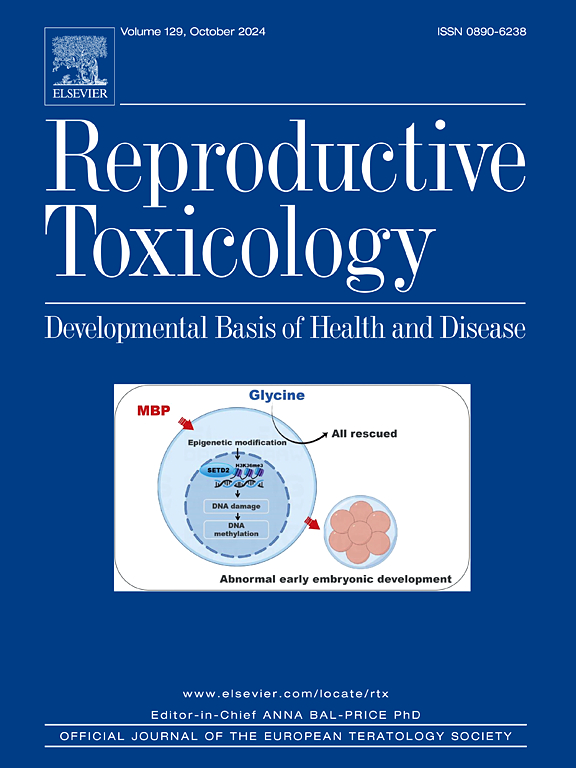Co-administration of atorvastatin with piperine induces reproductive toxicity in male Wistar rats through oxidative stress induction and downregulation of StAR, CYP11a1, 3βHSD and 17βHSD genes
IF 3.3
4区 医学
Q2 REPRODUCTIVE BIOLOGY
引用次数: 0
Abstract
Atorvastatin is a statin group of medicine that inhibits biosynthesis of cholesterol and mainly prescribed for treating cardiovascular diseases. Black pepper is a one of the mostly used spices that contains an alkaloid called piperine in its fruits which is known to cause male reproductive toxicity. Both atorvastatin and black pepper (piperine) are randomly consumed by the patients of chronic hyperlipidemia and it is important to know the synergistic effects of atorvastatin and piperine on male fertility parameters. Twenty rats were taken for the study and divided into four groups each containing five rats. Group I served as a control, group II animals are treated with atorvastatin (ATR) (8 mg/kg BW), group III animals received piperine (PIP) (10 mg/kg BW) and group IV animals were co-administered with piperine (10 mg/kg BW) and atorvastatin (8 mg/kg BW). All treatments were done by using water suspension of atorvastatin and piperine and using oral gavage for consecutive 28 days and thereafter assessed for gravimetric and histomorphometry analysis, sperm motility and morphology, ROS generation, anti-oxidant enzymes, serum testosterone quantification, qRTPCR (StAR, CYP11a1, 3βHSD and 17βHSD genes) and toluidine blue staining for analyzing chromatin integrity of spermatozoa. The results showed that co-administration of ATR+PIP significantly reduced body weight, changed in GSI also found. Activities of major two antioxidant enzymes (SOD and Catalase) were found to reduce whereas levels of TBARS and ROS in testicular tissues increased significantly. The study found that combined administration of atorvastatin and piperine negatively impacted male fertility potential, causing reproductive toxicity.
阿托伐他汀与胡椒碱联合给药通过氧化应激诱导和下调StAR、CYP11a1、3βHSD和17βHSD基因诱导雄性Wistar大鼠生殖毒性
阿托伐他汀是抑制胆固醇生物合成的他汀类药物,主要用于治疗心血管疾病。黑胡椒是一种最常用的香料,它的果实中含有一种叫做胡椒碱的生物碱,已知它会导致男性生殖毒性。慢性高脂血症患者随机服用阿托伐他汀和黑胡椒(胡椒碱),了解阿托伐他汀和胡椒碱对男性生育参数的协同作用很重要。选取20只大鼠,分为4组,每组5只。ⅰ组为对照组,ⅱ组给予阿托伐他汀(ATR)(8 mg/kg BW),ⅲ组给予胡椒碱(PIP)(10 mg/kg BW),ⅳ组同时给予胡椒碱(10 mg/kg BW)和阿托伐他汀(8 mg/kg BW)。所有处理均采用阿托伐他汀和辣椒碱水悬浮,连续灌胃28 d,随后进行重量和组织形态分析、精子活力和形态、ROS生成、抗氧化酶、血清睾酮定量、qRTPCR (StAR、CYP11a1、3βHSD和17βHSD基因)和甲苯胺蓝染色分析精子染色质完整性。结果显示,ATR+PIP联合用药显著降低了体重,GSI也发生了变化。睾丸组织中两种主要抗氧化酶(SOD和过氧化氢酶)活性降低,TBARS和ROS水平显著升高。研究发现,阿托伐他汀和胡椒碱联合使用会对男性生育潜力产生负面影响,导致生殖毒性。
本文章由计算机程序翻译,如有差异,请以英文原文为准。
求助全文
约1分钟内获得全文
求助全文
来源期刊

Reproductive toxicology
生物-毒理学
CiteScore
6.50
自引率
3.00%
发文量
131
审稿时长
45 days
期刊介绍:
Drawing from a large number of disciplines, Reproductive Toxicology publishes timely, original research on the influence of chemical and physical agents on reproduction. Written by and for obstetricians, pediatricians, embryologists, teratologists, geneticists, toxicologists, andrologists, and others interested in detecting potential reproductive hazards, the journal is a forum for communication among researchers and practitioners. Articles focus on the application of in vitro, animal and clinical research to the practice of clinical medicine.
All aspects of reproduction are within the scope of Reproductive Toxicology, including the formation and maturation of male and female gametes, sexual function, the events surrounding the fusion of gametes and the development of the fertilized ovum, nourishment and transport of the conceptus within the genital tract, implantation, embryogenesis, intrauterine growth, placentation and placental function, parturition, lactation and neonatal survival. Adverse reproductive effects in males will be considered as significant as adverse effects occurring in females. To provide a balanced presentation of approaches, equal emphasis will be given to clinical and animal or in vitro work. Typical end points that will be studied by contributors include infertility, sexual dysfunction, spontaneous abortion, malformations, abnormal histogenesis, stillbirth, intrauterine growth retardation, prematurity, behavioral abnormalities, and perinatal mortality.
 求助内容:
求助内容: 应助结果提醒方式:
应助结果提醒方式:


